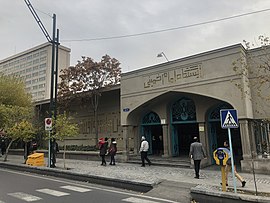
Back مترو طهران Arabic Tehran metropoliteni Azerbaijani تهران متروسو AZB Тәһран метроһы Bashkir Тэгеранскі мэтрапалітэн BE-X-OLD Техеранско метро Bulgarian তেহরান মেট্রো Bengali/Bangla Metro v Teheránu Czech U-Bahn Teheran German Metroo de Teherano Esperanto
| Tehran Metro | |
|---|---|
 | |
 | |
 | |
| Overview | |
| Native name | مترو تهران |
| Locale | Tehran, Iran |
| Transit type | Rapid transit/metro (Lines 1-4, 6-7) Commuter rail (Line 5) |
| Number of lines | 7 active lines |
| Number of stations | 159 (total)[1] [2] |
| Daily ridership | 2.5 million[3] |
| Annual ridership | 820 million (2018)[4] |
| Website | metro |
| Operation | |
| Began operation | 7 March 1999 |
| Operator(s) | Tehran Urban and Suburban Railway Company (TUSRC) |
| Number of vehicles | 1,514[5] |
| Technical | |
| System length | 224.6 km (139.6 mi) (metro) 67.5 km (41.9 mi) (commuter) 292.1 km (181.5 mi) (total)[6] |
| Track gauge | 1,435 mm (4 ft 8+1⁄2 in) standard gauge |
The Tehran Metro (Persian: مترو تهران, romanized: Metro-ye Tehrān) is a rapid transit system serving Tehran, the capital of Iran. It is the largest metro system in the Middle East.[7][8] The system is owned and operated by Tehran Urban and Suburban Railway. It consists of six operational metro lines (and an additional commuter rail line), with construction under way on six lines including northwestern extension of line 4, south extension line 6, northwestern and east extension line 7 and Line 10, Line 8 and 9.
The Tehran Metro carries more than 3 million passengers a day.[9] In 2018, 820 million trips were made on Tehran Metro. As of December 2023[update], the total system is 292.1 kilometers (181.5 mi) long, 224.6 kilometers (139.6 mi) of which is metro-grade rail. It is planned to have a length of 430 kilometers (270 mi) with eleven lines once all construction is complete by 2040.[10]
On all days of the week, the Metro service runs from 04:30 to 22:00.

The line uses standard gauge and is mostly underground. Ticket price is 3,500 Iranian Toman for each journey (about US$0.05), regardless of the distance traveled, but using prepaid tickets costs much less. Seniors may travel for free on the metro. On all Tehran metro trains the first and half of the second carriages from each end are reserved for women. Women can still ride other cars freely.[11]
- ^ "کارنامه ۲۸ ماه متروی تهران". Archived from the original on 31 October 2017. Retrieved 29 October 2017.
- ^ "بازگشایی ۵ ایستگاه جدید مترو". Retrieved 2 October 2023.
- ^ "روزانه ۲,۵ میلیون سفر توسط متروی تهران انجام میشود". Ana News Agency. 4 January 2015. Archived from the original on 12 August 2017. Retrieved 19 January 2020.
- ^ "کارنامه ۲۸ ماه متروی تهران". Archived from the original on 12 August 2017. Retrieved 19 January 2020.
- ^ امینی, اکرم. "هر ۳٫۴۰۰ مسافر یک واگن مترو". www.smtnews.ir. Archived from the original on 12 August 2017. Retrieved 15 July 2017.
- ^ "آشنایی با مختصات خطوط مترو تهران". Archived from the original on 16 October 2017. Retrieved 29 October 2017.
- ^ "World Metro Database". Metrobits.org. Archived from the original on 23 September 2010. Retrieved 12 August 2020.
- ^ "Tehran Metro". Railway Technology. Archived from the original on 22 December 2010. Retrieved 18 March 2020.
- ^ "Tehran Metro head resigns in row with Ahmadinejad". Reuters. 5 March 2011. Archived from the original on 4 July 2013. Retrieved 5 March 2011.
- ^ "Tehran Metro, Iran". Railway-Technology.com. Archived from the original on 1 July 2014. Retrieved 29 June 2014.
- ^ "خانه" (PDF). Tehran Metro (in Persian). Archived (PDF) from the original on 18 April 2016. Retrieved 6 January 2020 – via Google.
© MMXXIII Rich X Search. We shall prevail. All rights reserved. Rich X Search